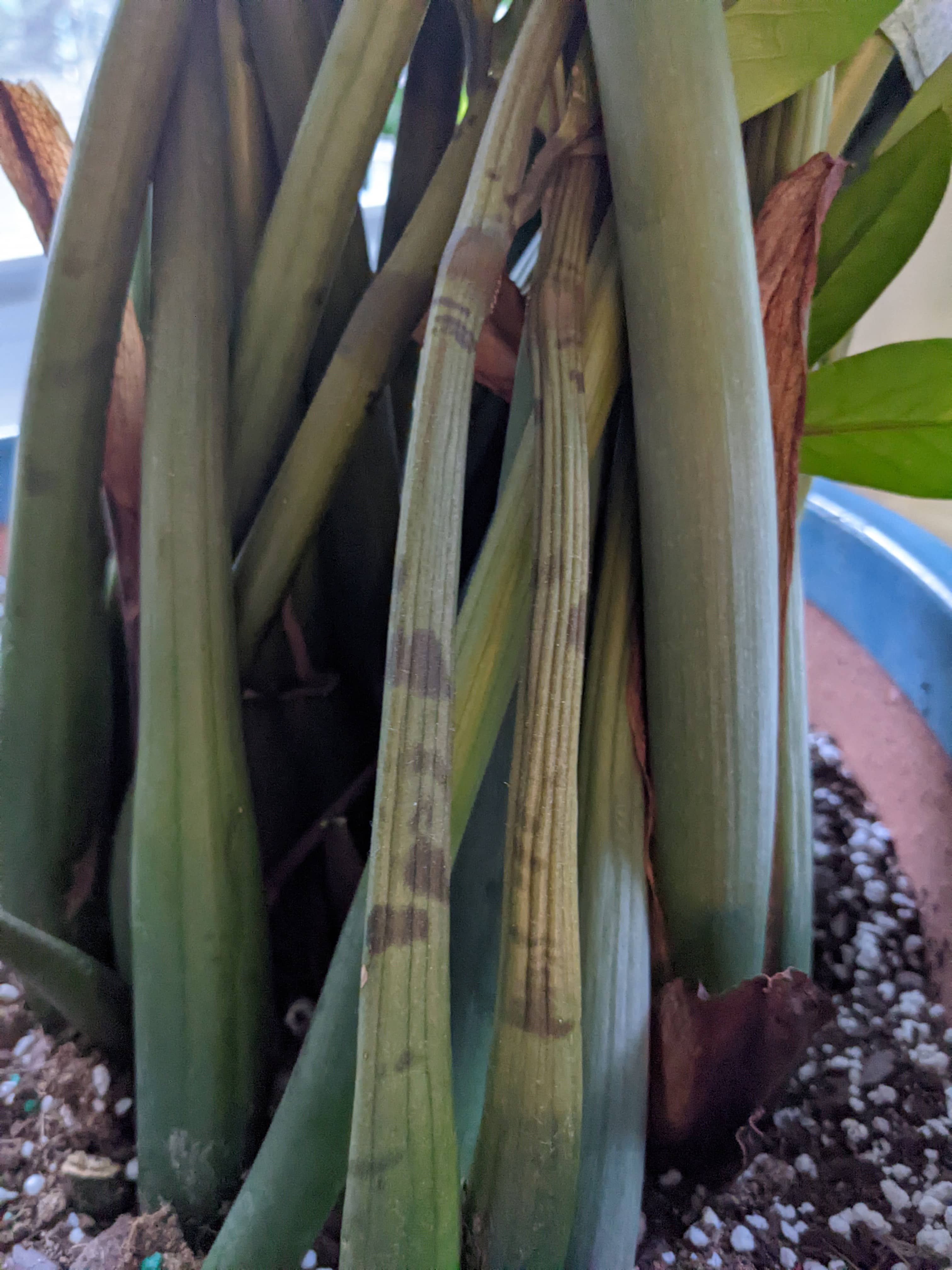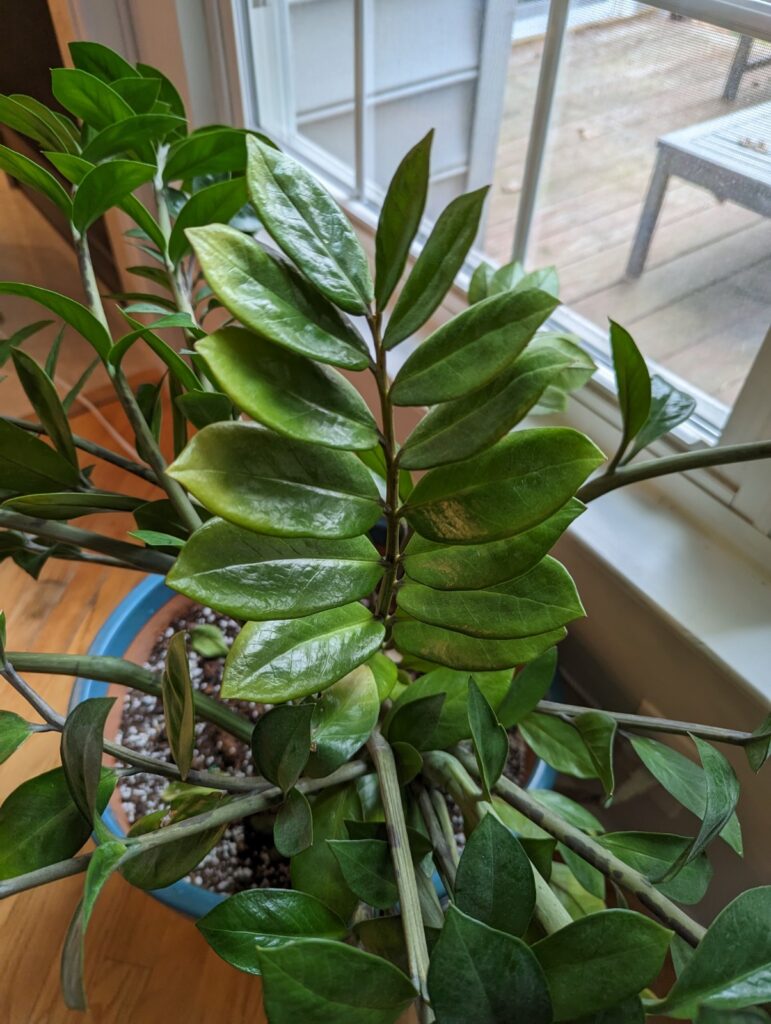Why is My ZZ Plant Yellowing?
ZZ Plants have shiny dark green leaves. They're a very popular houseplant because they are extremely easy to care for. And although they are easy, they can encounter issues such as yellowing leaves. Read on to learn some of the most common reasons for ZZ Plant yellowing and what you can do about it.
What Causes ZZ Plant Yellowing?
Water Issues
Water, or soil moisture, mismanagement is the most likely culprit when you notice that your ZZ Plant leaves are yellowing. Over and underwatering can cause the leaves to yellow, so you'll need to figure out which is your problem. For me, the best way to tell if there is a water issue is to use a soil moisture meter. I use something simple like this soil moisture meter. Some people use their finger to assess soil moisture by sticking it in the soil up to a knuckle or two. That seems too subjective to me, especially if you have a problem going on.
I have underwatered my ZZ Plant, in part due to it needing such infrequent watering. It can be hard to keep track of the last time you watered and therefore easier to neglect your waiting plans. If you have been underwatering though, I have found that the stems will wrinkle much sooner than the leaves turn yellow. So if you keep an eye on the stems that can be an early sign. See a picture below of wrinkled ZZ stems.

An overwatered ZZ Plant will have wet or very moist soil. Some leaves may have begun to turn yellow. In the case of overwatering, sometimes the leaves show brown splotches on the leaves as well.
How to Fix Water Issues
If you are underwatering, you'll just need to increase your watering in some manner. You can water more often or you may supply a larger amount of water each time you water. It's important to find a balance because you don't want to overdo it and go too far the other way. The yellow leaves on your ZZ Plant will not regain their color, unfortunately. You can let them fall off or pull them off if you want to. If the whole stem is full of yellowing leaves you may just want to trim back the whole thing. Once you begin increasing watering pay attention to whether the water just runs through soil rather than being absorbed. That's a sign that the soil may be hydrophobic and as a result, you may need to water from the bottom. That just means to stick your plant pot in a bowl or the sink with a few inches of water. Then the soil and roots have time to soak up water from the base of the plant.
If you have overwatered, the fix is more complicated. First, you must carefully remove your ZZ Plant from its pot. That will allow the roots, rhizomes, and soil to dry more quickly. Overwatered roots and rhizomes are very tender and vulnerable, so you must be careful and clean. Once the roots have dried enough to handle, you need to inspect them for rot. Rotten roots appear as an almost translucent brown and feel mushy. If you find rotten roots you need to cut them away with a clean sharp knife. Then you can repot your ZZ Plant in new soil and hope for the best.
Fertilizing Issues
Nutrients are the same as water where you can both over and under-fertilize. However, yellow leaves are more likely a sign of under-fertilization rather than over-fertilization. Overfertilized ZZ Plants are more likely to exhibit slow growth and maybe wilting. Typical houseplant fertilizers have a balanced ratio of nitrogen, phosphorous, and potassium, or n-p-k, which you see on the labels of plant fertilizers. Leaf yellowing may be a result of a lack of nitrogen or potassium. Nitrogen helps promote healthy foliage growth.

Signs of a fertilization issue generally show up on multiple stems and leaves, and not in a concentrated manner. When in doubt, I use soil rapitest to check my plants. It allows you to test for ph and each of the three main nutrients individually. There is no other way to be totally sure you have a nutrient issue, and if you have a lot of plants it's a good investment.
How to Fix Fertilization Issues
If you have overfertilized your ZZ Plant, you'll need to try to flush the soil by watering it a lot. Doing so will wash some of the excess nutrients out of the soil. When I have done this in the past I have even removed the plant from its pot because that allows it to dry out more quickly. All this may be pretty shocking to your plant, so don't be surprised if it looks worse off to start.
To fix an under-fertilized ZZ Plant, you need to fertilize it. Water-soluble or liquid fertilizers provide the quickest absorption. If you don't opt for the soil rapitest that I linked earlier, you are best off sticking with a balanced fertilizer that has the same number in the n-p-k ratio. However, if you know for sure you have either nitrogen or potassium deficiency, then you can find fertilizers that have higher ratios of the nutrient you need. It's important to follow the instructions on the fertilizing product because some fertilizers require dilution or that you water the plant beforehand.
Pests Issues
A wide variety of pests can attack ZZ Plants. The big ones that attack foliage, causing leaf yellowing, are aphids, scale/mealybugs, spider mites, and thrips. These pests feed on the leaves and ultimately destroy them. Yellowing from pest damage will appear spotty where the pests have fed. If you think you might have pests, you should do a close visual inspection of your plant as soon as possible. Use a flashlight to help you see contrast and shadows. In addition, pay close attention to the underside of the leaves because pests often hide there.
How to Fix Pest Issues
If you have pests, you must quarantine your plant away from other uninfested plants as soon as possible. Pests can hop plants, and they're good at it too. Next, follow this multipronged approach to address the pests. Remove as many pests as you can visibly see. Most pests can be removed by a strong spray in the shower or with a garden hose outside. I recommend the outside with a garden hose if you can. Who wants to spray pests in your house? Scale and mealybugs require manual removal because they have an armor-like shell that even a strong spray will not budge. You can pick them off pretty easily though.
Next use an insecticide. There are organic versions, like neem oil, and inorganic ones, like insecticidal soap. I have personally used neem oil on spider mites successfully. You're not done once you apply insecticide. You actually have to repeat removal and insecticide application every few days until you do not detect pests for over a week. The reason is pests have a short lifecycle. Although you don't see them, their eggs may still remain and could reinfest your plant.
Hopefully, this helps explain why your ZZ Plant is yellowing and now you're equipped with the knowledge to fix it. Have any questions? Post them in the Comments section below.
Add new comment